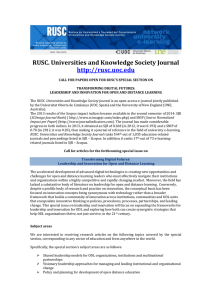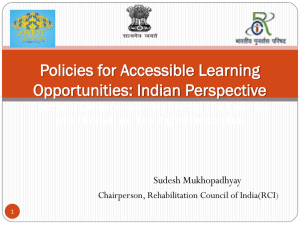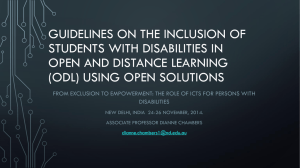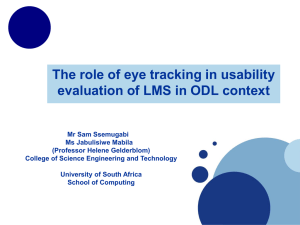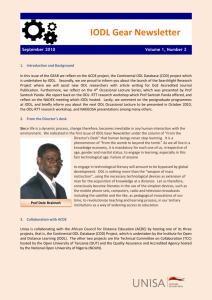- ALT Open Access Repository
advertisement
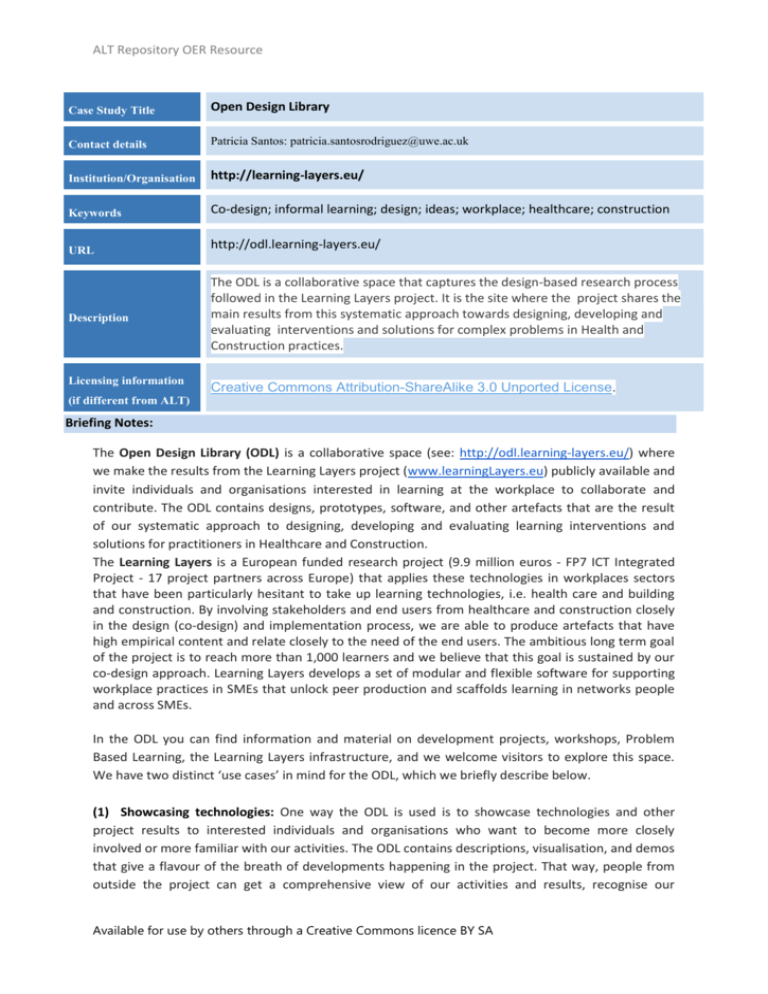
ALT Repository OER Resource Case Study Title Open Design Library Contact details Patricia Santos: patricia.santosrodriguez@uwe.ac.uk Institution/Organisation http://learning-layers.eu/ Keywords Co-design; informal learning; design; ideas; workplace; healthcare; construction URL http://odl.learning-layers.eu/ Description Licensing information The ODL is a collaborative space that captures the design-based research process followed in the Learning Layers project. It is the site where the project shares the main results from this systematic approach towards designing, developing and evaluating interventions and solutions for complex problems in Health and Construction practices. Creative Commons Attribution-ShareAlike 3.0 Unported License. (if different from ALT) Briefing Notes: The Open Design Library (ODL) is a collaborative space (see: http://odl.learning-layers.eu/) where we make the results from the Learning Layers project (www.learningLayers.eu) publicly available and invite individuals and organisations interested in learning at the workplace to collaborate and contribute. The ODL contains designs, prototypes, software, and other artefacts that are the result of our systematic approach to designing, developing and evaluating learning interventions and solutions for practitioners in Healthcare and Construction. The Learning Layers is a European funded research project (9.9 million euros - FP7 ICT Integrated Project - 17 project partners across Europe) that applies these technologies in workplaces sectors that have been particularly hesitant to take up learning technologies, i.e. health care and building and construction. By involving stakeholders and end users from healthcare and construction closely in the design (co-design) and implementation process, we are able to produce artefacts that have high empirical content and relate closely to the need of the end users. The ambitious long term goal of the project is to reach more than 1,000 learners and we believe that this goal is sustained by our co-design approach. Learning Layers develops a set of modular and flexible software for supporting workplace practices in SMEs that unlock peer production and scaffolds learning in networks people and across SMEs. In the ODL you can find information and material on development projects, workshops, Problem Based Learning, the Learning Layers infrastructure, and we welcome visitors to explore this space. We have two distinct ‘use cases’ in mind for the ODL, which we briefly describe below. (1) Showcasing technologies: One way the ODL is used is to showcase technologies and other project results to interested individuals and organisations who want to become more closely involved or more familiar with our activities. The ODL contains descriptions, visualisation, and demos that give a flavour of the breath of developments happening in the project. That way, people from outside the project can get a comprehensive view of our activities and results, recognise our Available for use by others through a Creative Commons licence BY SA ALT Repository OER Resource capabilities of developing tools and approaches for workplace learning, and understand where the project could potentially help them with their own needs and problems. Hence, the ODL is an important tool for stakeholder engagement in our project. Our expected short-term and medium-term effects of the ODL results on stakeholders are: 1. Stakeholders get a comprehensive view of Learning Layers design results. 2. Stakeholders gain confidence in the technological capability of Learning Layers. 3. Stakeholders want to engage with the Learning Layers project by participating through the ODL. (2) Participation: We invite the community to participate through commenting designed ideas. Commenting can occur through posts related with specific Learning Layers artefacts (i.e. prototypes, PBLs, studies of third party apps, etc.) which are updated regularly. The figure bellow illustrates an example of the exchange of ideas and conversations between two developers’ teams. In this case, the Help Seeking team is interested in finding examples of mobile apps implemented with HTML5 and WordPress. After using the ‘search’ feature, the ODL shows the Master Builder App as a good basis for their design idea (The Help Seeking tool). The Help Seeking team, can use the ODL to exchange discussions with the Aalto Team, iterate the functional requirements and re-adapt the code by using the Requirement Bazaar. The source code developed in Learning Layers can be found in the Learning Layers Sourceforge. The Requirements Bazaar and LL sourceforge are part of the Open Developer Library. Available for use by others through a Creative Commons licence BY SA ALT Repository OER Resource How to participate and join? Comment existing designs and ideas Suggest a new idea Suggest a new design Announce a new course or workshop related to learning at work Improve any of the existing ideas or designs All these require you to join the ODL. It is quick, easy and free. Currently, the ODL contains 25 design artefacts , including ideas such as: Interaction guidelines (to help Learning Layers to design and develop tools that are responsive and a provide pleasure in use), a mobile video recording app (Ach So!) to support practices at construction and training sets, a mobile app to improve reflection by recording ideas and learning (Reflect), a set of user stories that illustrate learning situations at the Healthcare and Construction sectors, among other offerings to solve complex learning problems in workplace environments. Available for use by others through a Creative Commons licence BY SA
